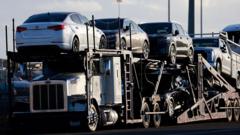The newly implemented 25% tariffs on car parts entering the US come as an effort to boost local manufacturing but create a landscape of uncertainty for automotive companies and consumers alike, leading to anticipated price increases.**
New Tariffs on Car Parts Impact US Automotive Industry Amidst Economic Uncertainties**

New Tariffs on Car Parts Impact US Automotive Industry Amidst Economic Uncertainties**
A 25% import tax on engines and transmissions now places added strain on US car manufacturers, intensifying costs and pricing concerns.**
A significant shift in US automotive policy has just taken place with the enforcement of a 25% import tax on essential car parts, including engines and transmissions. This action comes at a time when the industry already faces mounting pressure due to a series of policy shifts aimed at emphasizing domestic manufacturing.
The introduction of these tariffs follows shortly after former President Donald Trump had slightly adjusted the measures to alleviate some concerns from businesses. However, despite the easing, the tariffs remain intact, with the intention of incentivizing car makers to increase production in the United States.
Industry experts, however, caution that while some companies may consider scaling up operations domestically, these expansions are unlikely to occur without offsetting reductions in production elsewhere, ultimately passing the costs onto consumers. Sales remain robust at the moment; General Motors and Ford reported significant sales growth for April, attributed to strategy adjustments in response to potentially higher prices.
Nevertheless, General Motors has forecasted an impending cost surge of up to $5 billion this year due to tariffs, which includes considerable expenses originating from South Korea. Executives have revised previous expectations, now forecasting a 1% increase in consumer prices instead of price reductions.
In light of the current turmoil, automobile manufacturers like Stellantis, which oversees brands such as Jeep, Fiat, and Chrysler, have announced the withdrawal of their financial forecasts due to the evolving landscape of tariffs. Stellantis Chief Financial Officer Doug Ostermann commented on the considerable uncertainties affecting their outlook.
Historically, a substantial portion of vehicles sold in the US arrives from overseas markets. The alarming announcement of tariffs on cars and car parts last month triggered widespread concern across the automotive sector, igniting fears of increased prices and potential threats to both production and sales.
While Trump has enacted some exemptions for parts manufactured in Mexico and Canada—nations with which the US has a longstanding free trade agreement—these exemptions were initially hinted as temporary. New customs guidance has suggested that these rules might remain in place for an extended period, easing some burdens temporarily.
Additionally, Trump recently established safeguards to prevent overlapping tariffs on identical goods and introduced a new two-year framework that allows manufacturers to lessen duties on foreign parts used in vehicles assembled in the US.
Though some firms are exploring the option of bolstering domestic production to adapt to the recent economic climate, the journey to establishing new factories is fraught with financial implications. Industry analysts, like Stephanie Brinley from S&P Global Mobility, describe the current tariff landscape as a dramatic upheaval but express caution against the likelihood of new plants materializing swiftly.
Art Wheaton, Labor Studies Director at Cornell University, echoes these sentiments, emphasizing the unpredictability of the market and advising against hasty investment decisions in such an unstable environment. The administration is currently negotiating trade agreements with essential partners like South Korea and Japan, while also open to re-evaluating its tariff positions if economic consequences become evident.
"Everything is pretty good now," Wheaton noted, cautioning that the full ramifications of the tariffs have yet to unfold, leaving the automotive industry in a state of flux as it navigates this new terrain.





















